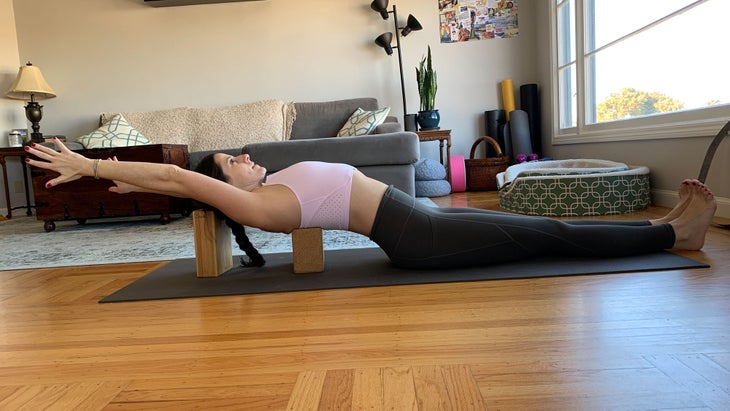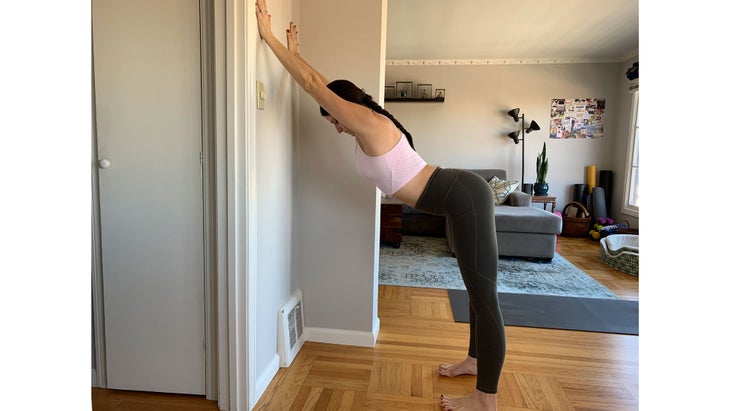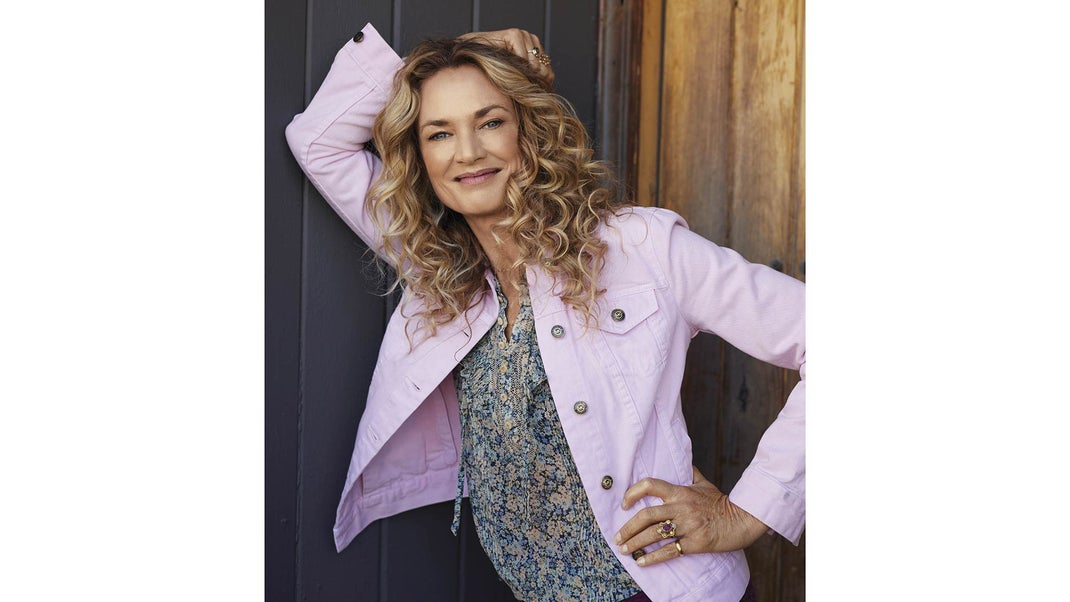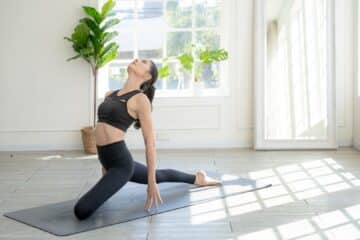Yoga is a great way to relieve stress and feel energized. But for many people, the thought of doing yoga can be intimidating. 7 Gentle Backbends for Beginners (Or Anyone, Really) is a blog post that will help you get started with your yoga practice in 7 easy steps!
I was hooked on Urdhva Dhanurasana from my very first yoga class. For years, I couldn’t quit doing the rather intense backbend pose commonly referred to as Upward Bow Pose or Wheel. No other backbend could compete with pressing my hands and feet into the mat, straightening my arms and legs, and opening my chest to the heavens.
I had to do Urdhva Dhanurasana in order to feel complete. It didn’t matter if I completed any other backbends; nothing else was able to satisfy me.
Later, when I started learning how to drop back into the Wheel from standing, all bets were off. I would do the sequence at the end of each practice and later buzz as if I’d downed an entire pot of coffee. It was thrilling.
Is it necessary to come into intense backbends?
In her book Yoga Mind, Body & Spirit, master teacher Donna Farhi says that backbends are “powerful healers, and like all strong medicine, they have the potential to be injurious if practiced without discretion.” I had definitely overdosed on my medicine.
The wheel was easy for me at first because I could come into it by literally dislocating my arms from their socket. (Are you squirming? Chances are you do the same thing to some extent. In fact, most of us do.) Practice backbends in this manner a few times and it may not make a difference; continue doing this decade after decade and your shoulders will likely pay the price.
How to do a backbend safely
What I realized later is that I put my body at risk for the sake of a shape. After years of overindulging in deep backbends, I have come to a new appreciation for the entire spectrum of this family of postures.
I finally understand the importance of each variation of backreading and understand that “going deeper” is not synonymous with overexertion. In fact, what I now know to be true is that in yoga, “going deeper” means being more mindful, more kind, and often doing less.
Urdhva Dhanurasana is not the be-all and end-all of backbends. In fact, it is only the beginning. There are a number of other backbends that are even healthier for most bodies. If you’re like me, it’s OK to hold a special place in your heart for Urdhva Dhanurasana. But get ready to have your world—and your heart—blasted wide open with these less-demanding alternatives to Wheel Pose that will feel equally astounding.
7 best backbend poses for beginners (or anyone, really)
1. Standing C-Clasp
Start in Tadasana (Mountain Pose) with your feet hip-width apart. Interlace your fingers behind your back or, if your shoulders are tight, grasp a strap. Ground into all four corners of your feet. Press your thighs toward the wall behind you as you let your sit bones release toward the mat.
On an inhalation, lift your chest and on an exhalation, begin to arc backward, as if you were reaching your knuckles to the ground. Keep your low belly engaged by gently lifting your front hip bones toward your front ribs.
Your chest should be broad and lifting; your shoulder blades should support the opening of your chest. If it is OK for your neck, look up to the ceiling. Stay here for up to 10 deep breaths. To slowly come out, on an inhalation ground into your feet, continue to press your thighs back, and return to standing. Exhale and pause in Mountain Pose.
2. Anahatasana (Melting Heart Pose), Variation
Stand facing a wall with your toes touching the baseboard. Inhale your arms overhead, your arms shoulder-distance apart, and place your palms flat onto the wall. Step back two to three feet (depending on your height).
Bend at your hips, reaching your bum away from the wall toward the center of the room. Walk your feet back until your hips align over your heels. Keeping a little more weight toward your knuckles, begin to melt your heart toward the floor.
Resist letting your upper arms flare out as this causes you to dump into your shoulders, which will compress your neck and impede any opening in your chest. Instead, wrap your outer upper arms (your triceps) inward and down and resist letting your forearms slide down toward the floor.
Release your chest toward the floor and lift your front ribs away from the floor. By working the counteractions of the arms and lower ribs resisting the floor, it helps target your heart space. Breathe here for 10 breaths. When it is time to come out, lift your head and slowly walk back to the wall. Repeat once.
3. Salabhasana (Locust), Variation
Start laying down with your tummy on the floor. Stretch your arms out in front of you as wide as your shoulders. Come onto your fingertips and lift your forearms away from the floor. Keep your outer upper arms hugging in toward your ears and separate your legs and feet as wide as your hips, curling your toes under.
Lift your thighs up to the ceiling as you gently press your pubic bone into the floor to lengthen your low back. On each inhalation, press your fingertips against the floor to reach your chest forward while reaching your heels toward the back of the room.
Lift your head while continuing to firm your upper arms in toward your ears. On each exhalation, keep your low belly slightly engaged by lengthening your low back. Stay here for 10 breaths. On an exhalation, slowly lower down and rest before repeating two more times for a total of three rounds. When you’re done, press up to Chaturanga Dan asana (Plank or Four-Limbed Staff Pose) for a few breaths.
4. Satu Bandha Sarvangasana (Bridge Pose), Variation
Contrary to popular belief, Bridge Pose is not just some precursor to Wheel. It is a strong backbend in its own right, teaching us the power of the legs and their important part in chest opening. Start on your back with your feet hip-distance apart and your knees aligned above your ankles.
On an inhalation, lift your hips by lengthening your tailbone toward your knees. Keep your inner thighs turning in and releasing down toward the floor. Roll your upper arms underneath you until the pinky edges of your hands and outer wrist are karate-chopping into the floor.
Imagine you are holding a large beach ball underneath you. Press your outer shoulders into the floor to help broaden your chest and keep your chin level to your chest. The back of your head should very gently press into the floor to help your heart swell even more. Hold for 10 breaths. On an exhalation, slowly lower one vertebra at a time to the mat. Pause and repeat two more times.
5. Purvottanasana (Upward Plank Pose)
Start sitting on your mat with your legs straight out in front of you. Place your hands next to you, slightly behind your hips, fingertips pointing forward. On an inhalation, press into your hands to lift your back body away from the floor.
Straighten your legs and point your toes toward the mat. If straightening your legs is not accessible, you can bend your knees. Keep pressing through your hands and firming your arms. You can gaze at your belly button or, if your chest is lifting and you do not have any neck issues, you can release your head back and look toward the back wall. Stay here for 8 breaths. On an exhalation, slowly start to lower to your bum. Sit upright for a few breaths.
6. Dhanurasana (Bow Pose), Variation
Make a small loop with a strap and tether it around your ankles. Keep the tail end of the strap over your right shoulder and come onto your belly. Bend your elbows and your knees and walk your hands “down” the strap (toward your ankles) until it feels taught.
Pause here and lengthen through your low back by reaching your tailbone toward your heels. On an inhalation, lift your upper body and inner legs from the floor. Make your way with your hands further down the strap as if you could one day grab your heels.
Your arms will start to straighten; allow them. Strongly lift your thighs away from the mat, keeping your pubic bone connected to the floor. Hold for 8-10 breaths. (We will do 3 full rounds, so do less on the first one.) To release, loosen the hold on the strap and slowly lower to the floor, one rib at a time. Repeat two more times for a total of 3 rounds. When complete, windshield-wiper your legs to release your low back.
7. Matsyasana (Fish Pose), Variation
Set up two blocks in a T-shape, with the block closest to the back of your mat on the tallest setting and the second block a little more than a foot closer to you on the medium setting. Sit on the floor in front of the blocks and lay back so that both shoulder blades are flat against the lower block and the base of your skull is supported by the taller block. Your legs can be straight, or, if your low back is tender, bend your knees. Start here for 10-15 breaths with your arms wide to the sides and your elbows bent. This is an excellent chest opener.
Next, reach your arms straight up to the ceiling, palms facing one another. On an inhalation, slowly take your arms overhead. Respect your limits. Your ribs act as a brake, preventing your arms from going too far, which would lose the stretch. This pose can be done dynamically, inhaling your arms overhead and exhaling them back to chest level a few times. You can also simply hold your arms overhead for 20 breaths. Play with both to see which is right for you.
When you are ready to come out, widen your arms to your sides and once again rest against the blocks in the restorative fish shape. Bend your knees, placing your feet on the floor, and roll to your right, laying on your right arm for a few moments. Use your left hand to press up to slowly move up to sitting, lifting your head last. You may want to do a gentle seated twist with crossed legs afterward this pose to release your low back.
Conclusion:
Want to deepen your yoga practice? Join Outside and get unlimited access to exclusive articles, sequences, meditations, and life experiences—as well as thousands of healthy recipes and meal plans from Clean Eating and Vegetarian Times.




